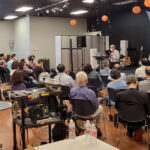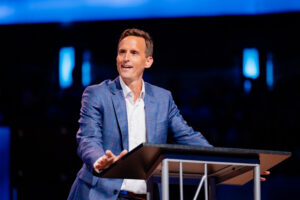

See charts of survey results at the bottom of this article.
Southern Baptist pastors are strongly supportive of the Convention’s Cooperative Program, according to a study commissioned by the SBC Executive Committee last spring. The survey shows an increase in confidence that the Cooperative Program supports the ministries and missions valued by their churches (81 percent), up from 73 percent in a 2012 survey that asked the same questions to a set of randomly-selected pastors and 71 percent in a similar survey conducted in 2008 that included pastors, laypersons, and other church staff.
Conducted by LifeWay Research, the 2014 survey of 1,097 Southern Baptist pastors found 86 percent agree the Cooperative Program fuels an aggressive global enterprise of reaching the unreached people groups around the world. This is up 5 percentage points over the 2012 survey. Similarly, 83 percent say the Cooperative Program provides partnership opportunities for local, state, and national missions, 3 percentage points greater than the 2012 survey.
The study also indicates that pastors’ support for the Cooperative Program does have its limits. One in eight pastors (13 percent) say the strategies of the SBC entities that receive Cooperative Program dollars are not moving in the appropriate direction, with the same number expressing that SBC entities are not using their contributions effectively. However, almost two-thirds (65 percent) agree the SBC entities supported by the Cooperative Program are moving in an appropriate direction. More than six in ten (63 percent) say the entities are using their contributions effectively.
“This is encouraging news,” said Ashley Clayton, Executive Committee vice president for Cooperative Program. “A few years ago, a Florida pastor told me the Cooperative Program would have to compete for his church’s missions dollars. More recently, he told me, ‘Count Me In,’ in support of the CP.” The pastor’s confidence in the CP increased as he watched what he called a “renewed focus” by the SBC entities responding to “the values his church embraces,” Clayton said. “I believe this report shows that he is not alone.
“However, the survey also shows we still have a way to go to earn the trust of all our pastors,” Clayton said.
Cooperative Program Allocations
Southern Baptist pastors also indicated that they generally agree with the current allocation of national Cooperative Program funds for the entities that receive Cooperative Program funding—International Mission Board (IMB), North American Mission Board (NAMB), six SBC seminaries, Ethics and Religious Liberty Commission, and SBC operating budget. The median responses were all within 1.2 percent of current allocations, which the pastors were shown as they answered, with 15 percent selecting the current distribution percentages as their preference.
Just more than half listed higher percentages for NAMB, ERLC, and the SBC operating budget, while almost half listed slightly lower percentages for IMB and the six SBC seminaries.
“This is the third survey of pastors the Executive Committee has commissioned since 2007,” Clayton said. “We continue to see strong pastor support for the current allocation of the SBC portion of CP funds. In all three surveys, pastors indicated their agreement that IMB should receive about 50 percent of the SBC CP allocation budget, our seminaries should receive slightly less, with the difference distributed to small increases for NAMB and ERLC,” Clayton said.
A large majority of pastors have affirmed the statement “the Cooperative Program supports missions and ministries that my church values” in all three surveys, he said.
More than three-fourths (77 percent) agreed with the statement, “The SBC allocation budget places a high priority on penetrating lostness both locally and worldwide.”
Ministry Priorities
Pastors were also asked to indicate the priority their churches place on twelve missions and ministry efforts funded by the Cooperative Program. “Sending and supporting overseas missionaries to reach unreached people groups around the world” continues to be the highest priority for pastors. It is the only ministry selected by more than 70 percent of pastors as “essential” or a “high priority” (71 percent), up 3 percentage points from the 2012 survey; and it is the only ministry effort that fewer than 10 percent of pastors rated a “low priority” (6 percent) or “not a priority” (2 percent).
The most notable change was reflected in pastors’ desire for the SBC to provide “a Christian perspective and response about social, ethical, and public policy issues” (54 percent selecting it as “essential” or “high priority,” up from only 37 percent in 2012).
Following is the percentage of SBC pastors who rated each CP-funded mission and ministry as “essential” or “high priority”:
In the 70 percent range
- Sending and supporting overseas missionaries—71 percent (68 percent in 2012)
In the 60 percent range
- Engaging in local ministry projects for evangelism—66 percent (65 percent in 2012)
- Developing and implementing an evangelism strategy for penetrating lostness in North America—63 percent (59 percent in 2012)
- Improving the vitality and health of existing churches—62 percent (59 percent in 2012)
In the 50 percent range
- Educating and training future pastors, missionaries, church planters, and other denominational leaders—57 percent (57 percent in 2012)
- Providing a Christian perspective and response about social, ethical, and public policy issues—54 percent (37 percent in 2012)
- Reaching ethnically and culturally diverse people—52 percent (51 percent in 2012)
- Promoting an ongoing program of missions education for all ages—51 percent (48 percent in 2012)
- Conducting an ongoing program of leadership development—50 percent (45 percent in 2012)
In the 40 percent range
- Engaging in direct international missions—48 percent (45 percent in 2012)
- Intentional church planting in cities and towns across North America—44 percent (44 percent in 2012)
- Intentional church planting in large urban centers—43 percent (43 percent in 2012)
“While international missions remains the highest priority for the Cooperative Program, pastors also place a high priority on participating in local ministry projects for evangelism, developing and implementing an evangelism strategy for penetrating lostness in North America, and improving the vitality and health of existing churches,” Clayton said.
“It is not a case of either/or,” he said. “Pastors see value in both/and—supporting an aggressive global vision while simultaneously strengthening a strong home base.”
Statistical Differences
Significant statistical differences emerged among pastors based on location, age, and church size.
Pastors in the Northeast are more likely to select “reaching ethnically and culturally diverse people in large cities across North America” as “essential” (27 percent) compared to churches in the South (17 percent) and the Midwest (11 percent).
Younger pastors, age 18–44, are more likely to view “sending and supporting overseas missionaries to reach unreached people groups” as “essential” (38 percent) than pastors 65 and older (29 percent).
Pastors in the West (24 percent) and Northeast (28 percent) are more likely to view “intentional church planting in cities and towns across North America” as “essential” than pastors in the South (15 percent) and Midwest (11 percent).
Pastors of churches running 0–49 and 100–249 are more likely to select “improving the health and vitality of existing churches” as “essential” (32 percent and 30 percent respectively) than churches running 250 or more (19 percent). Older pastors, 65 and up, view this as a “high priority” (37 percent) or “essential” (24 percent).
Younger pastors (age 18–44) and older pastors (age 65 and over) are more likely to “strongly agree” that “the SBC entities supported by the Cooperative Program are moving in the appropriate direction with the strategies they have in place” (30 percent and 31 percent respectively) than pastors age 45–54 (20 percent).
In regards to educating and training future pastors, missionaries, church planters, and SBC leaders, younger pastors, age 18–44, are more likely to say it is “essential” (33 percent) compared to pastors age 55–64 (25 percent) and age 65 and up (23 percent).
When asked about engaging in direct international missions projects, differences mainly emerged according to church size. Churches with 250 or more in attendance are the most likely to say it is “essential” (31 percent), while churches running 50–99 and 100–249 are more likely to select “medium priority” (24 percent and 33 percent respectively).
In perhaps the most telling generational difference, only 1 percent of younger pastors “strongly agree” that the “Cooperative Program supports SBC ministries and missions that my church values,” although another 36 percent “somewhat agree.” On the other hand, 53 percent of pastors 65 and up “strongly agree” with the statement, with another 26 percent “somewhat agreeing.”
Church Contributions through CP
The Executive Committee also asked pastors about the decision their churches made regarding contributions through the Cooperative Program in the most recent budget process. The vast majority of churches (80 percent) decided to keep their CP giving the same as last year. Three times as many churches raised their CP contribution (12 percent) as decreased it (4 percent). Three percent said their church does not contribute through the CP.
Of churches making a change in their giving through the Cooperative Program (almost 20 percent of the churches surveyed), 5.6 percent increased it by more than 2 percentage points of the church’s undesignated receipts, with another 9 percent increasing their CP contributions from 0.1 percent to 1.9 percentage points of their budget. On the other hand, 4.8 percent of churches decreased their contribution through the CP.
The final question on the survey referred to the “1% CP Challenge,” an effort by the SBC Executive Committee to encourage all Southern Baptist churches to raise their Cooperative Program contributions by one percent of their church’s undesignated contributions. More than one-fourth of pastors had not heard of the “1% CP Challenge” (28 percent). Forty-nine percent said they have not accepted the challenge. Eight percent of pastors said their church had accepted the “1% CP Challenge” and another 9 percent plan to do so in the next budget year.






















